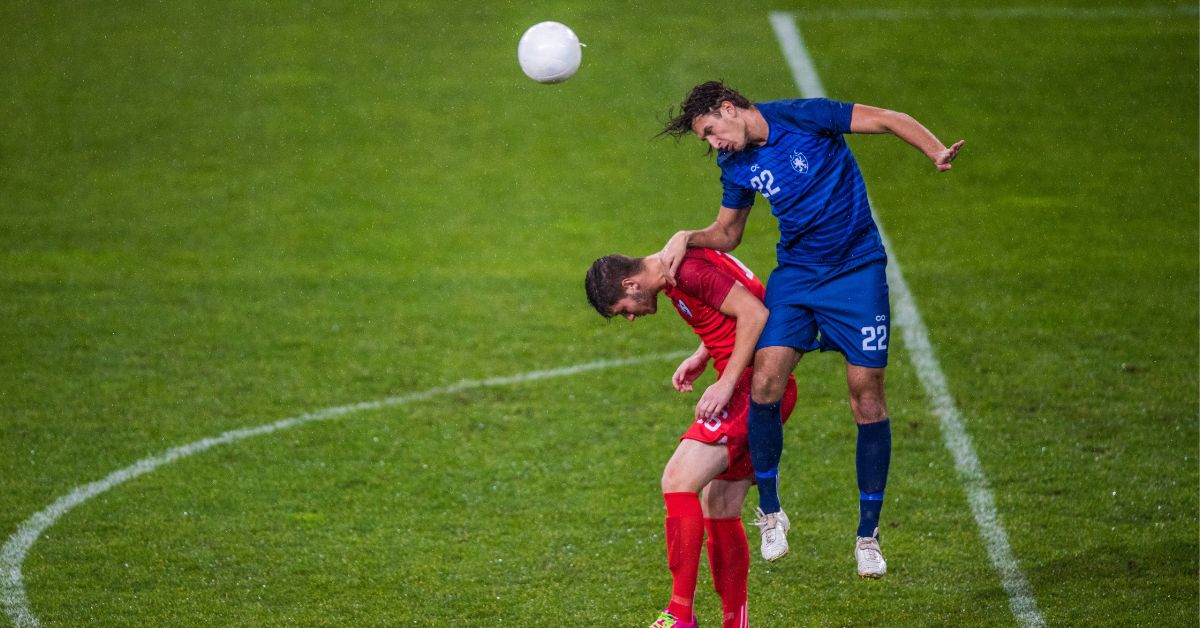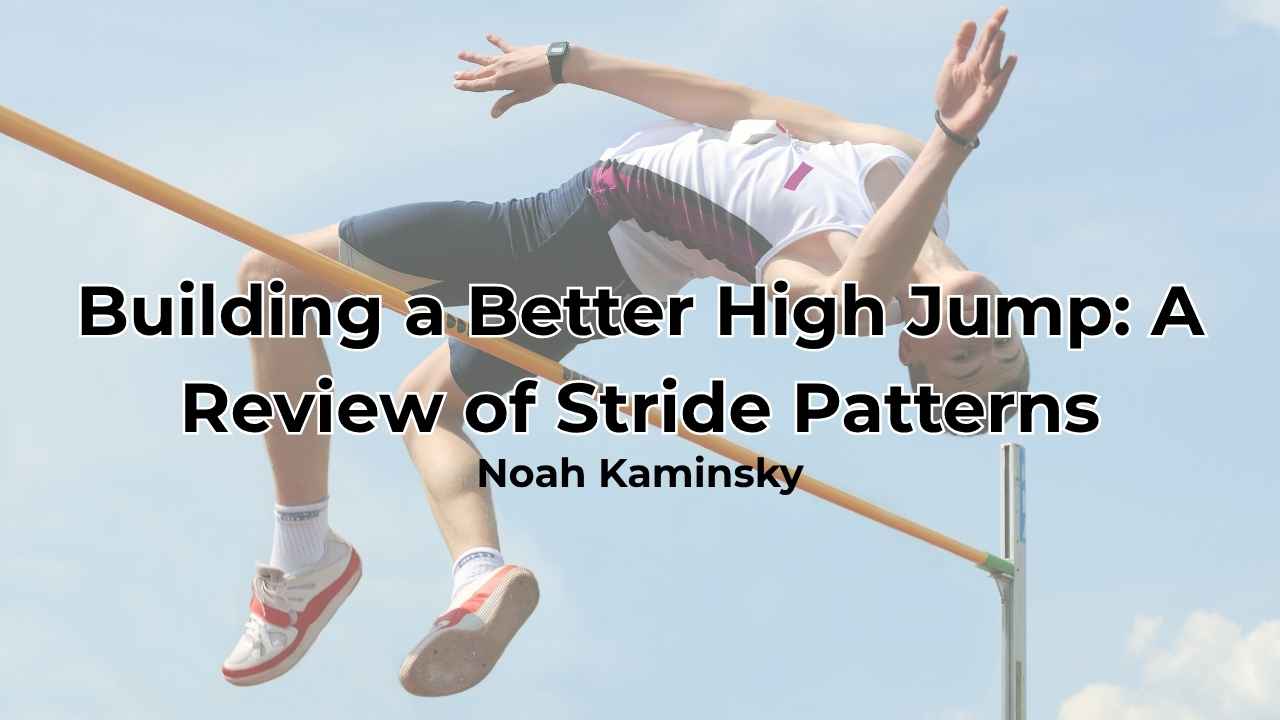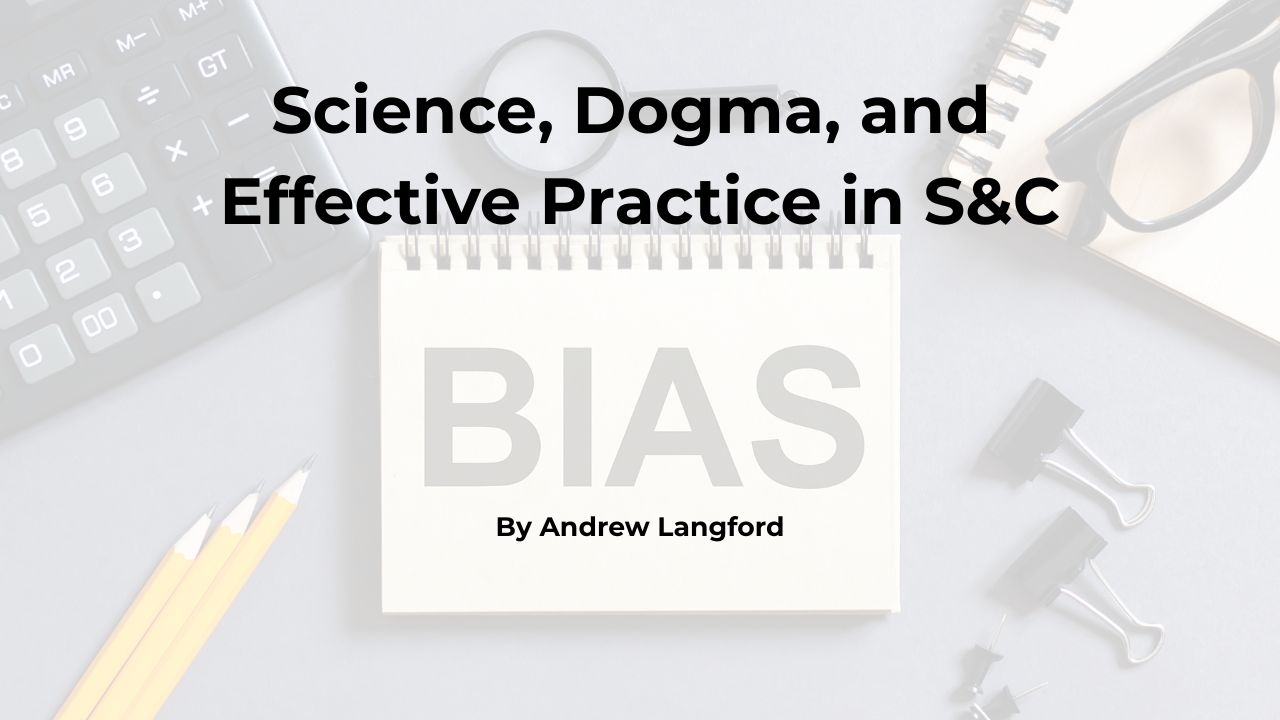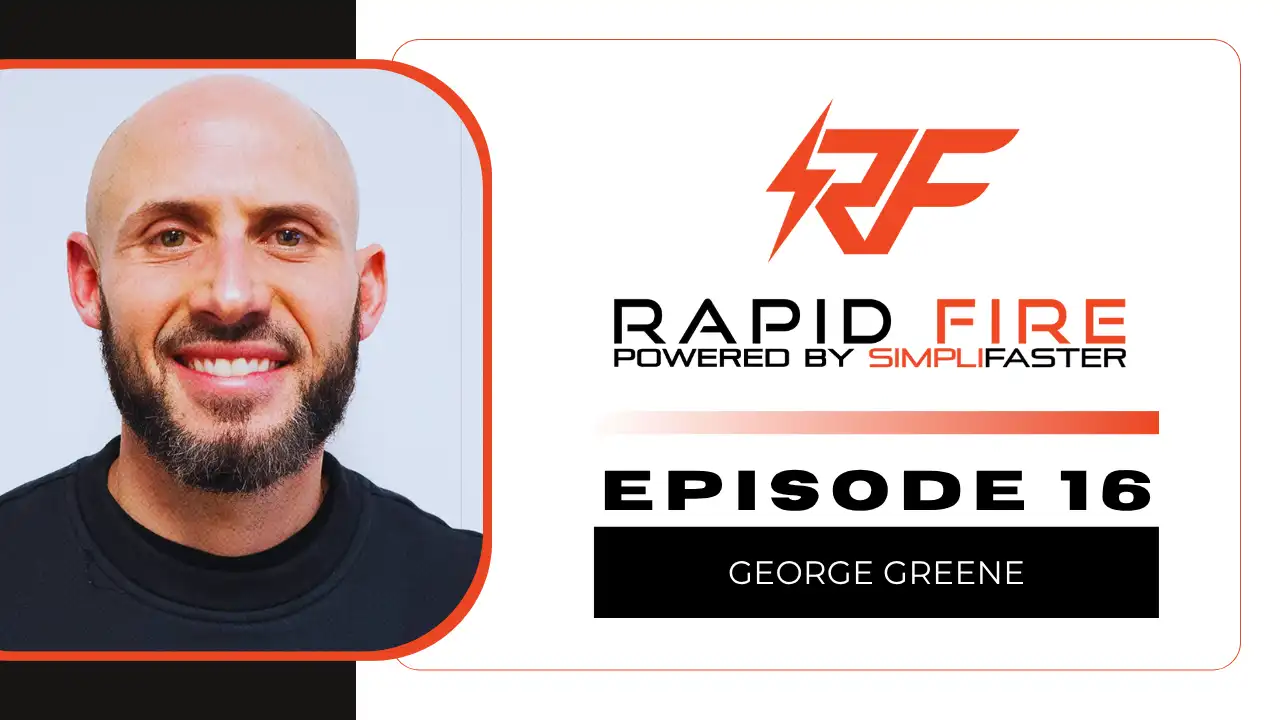If it were possible to decrease the risk of ACL tears through training, would you do it? What if it were possible to decrease the risk of something more sinister—like suicide—with performance training? While having a bond is certainly powerful, there’s more to the puzzle than social impact.
Our brain is our most sensitive organ, standing distinct amongst its peers. Kidney damage doesn’t change who we are. You can remove a lung and although there are consequences, you don’t fundamentally change.
Yet if any part of your brain is damaged, the shockwave can be felt in every ripple of your existence. Personality, mood, thought patterns, beliefs, morals, behaviors…all of this—which makes you who you are—can be affected by brain trauma.
So if we can protect athletes’ brains with training—shouldn’t we?
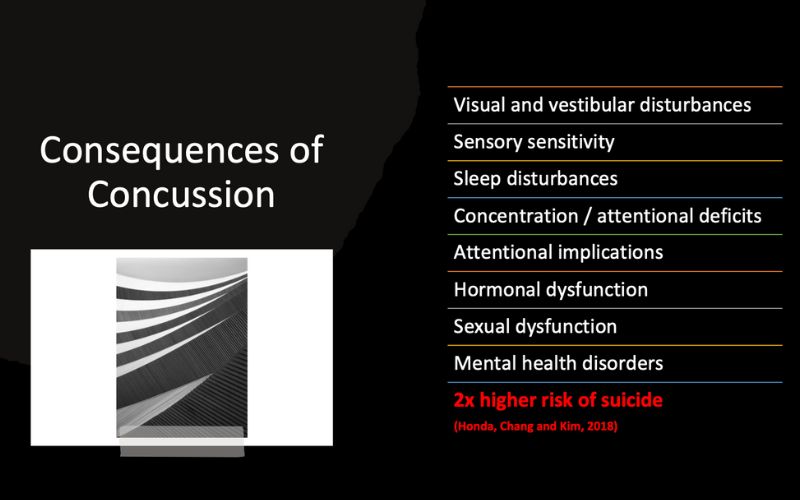
I am certainly not the first to consider neck training for brain and overall athlete health. Carl Valle and others have long advocated for total athlete health, including neck training for brain health and concussion prevention.
Here, I propose evidence and frameworks that perhaps have been considered, but I’ve not yet seen discussed by others.
Muscular and Neurologic Anatomy
The neck musculature is similar to the hand and wrist in that there are several layers of muscles, and none of us want to remember all their names.
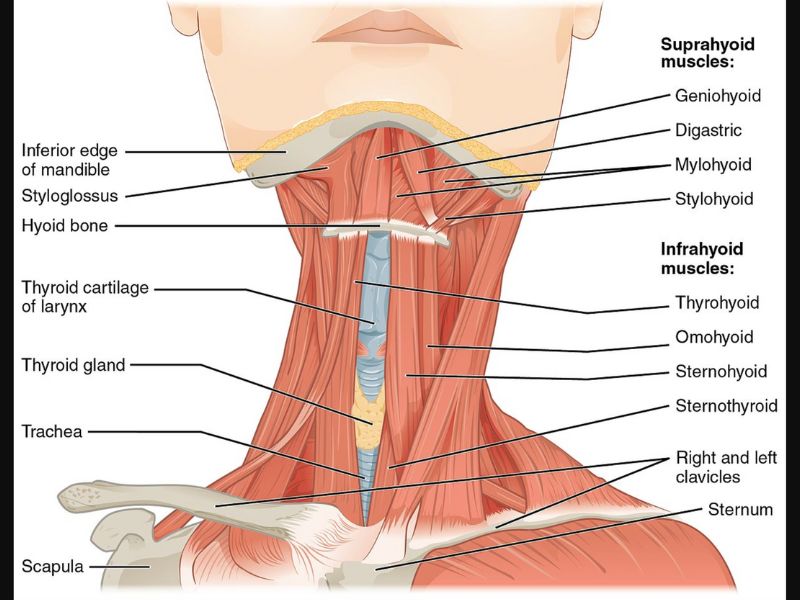
Figure 2. Anatomy of the neck, showing both the deep and superficial musculature.
Created by CFCF, Creative Commons License.
You don’t need to have an intimate understanding of the neck musculature. Rather, I’ve come to understand that there are essentially two functions of neck muscles: cervical stability and head movement.
Stability, a buzzword as it may be, means resisting movement. Thus, cervical stability is preventing the deformation of the cervical spine. In other words, staying still (or perhaps more colloquially, “staying strong”) when taking a hit.
All of the neck musculature contributes both to head movement and cervical stability. We can also appreciate that the larger, superficial muscles—such as the superior trapezius and the levator scapulae—attach to the head itself, while the deep cervical muscles tend to originate from and attach to the cervical spine.
Thus, there are two levels of movement and stability forces: some which act primarily on the cervical spine itself and others that act on the cervical spine and the head. Whether directly or indirectly, all of the neck musculature stabilizes the cervical spine and head in addition to causing movement.
In nature, one primary function of the neck is to keep the head vertical in order to maintain visual and vestibular equilibrium. We see this in animals like cheetahs turning a corner, or players like Messi striking a ball.
It is not surprising, then, that the neck is highly dense with sensory receptors. Specifically, the neck is rich with visual and vestibular afferent neurons. Thus, this region is significant beyond keeping the head upright—it has significant dialogue with the brain regarding the perception of space and proprioception in general.
The neck is significant beyond keeping the head upright—it has significant dialogue with the brain regarding the perception of space and proprioception in general, says @KD_KyleDavey. Share on XAccordingly, I now view the neck itself as a sensory organ. This same thought process has led some researchers to wonder:
“If the neck is a sensory organ, what happens when it fatigues?”
Neck fatigue impairs postural and oculomotor control. The reasons for this are not entirely clear, but one hypothesis is that fatigue of the neck musculature impairs the afferent feedback of the sensory receptors, thus sending convoluted or otherwise unclear messaging to the brain.
If you aren’t well-versed in neurology, this may sound like mumbo jumbo at best or witchcraft at worst. My brain works in analogies. Imagine sitting at the end of a long road, lit by streetlights placed every 30 yards or so. You can see the whole road—say a quarter mile. Then, one of the lights goes out. You now have a slightly worse understanding of what’s happening in that unlit spot.
Now imagine cars are speeding towards you. If all the street lights are lit, great—you see the cars and can move out of the way well before they reach you. But what if some lights are out? You lose the car when it drives through the dark spots. No problem, because they eventually come back in the light, but you have less time to react. It’s a bit nerve racking when you lose track of them in the dark.
Such it is with our senses. They are the lights by which our brain understands what is happening in the world around us. And if they are interfered with, we have a worse understanding of the world, and outputs are thus compromised.
What’s more, neck fatigue and stiffness decrease upper extremity motor accuracy and joint proprioception. In laymen’s terms: neck fatigue decreases the ability to reproduce specific upper extremity movements and position with precision. It makes it harder to do the same movement over and over. It (involuntarily) increases movement variability when the goal is not to have variability.
Neck Fatigue and Movement Implications
As a young QB, one of my downfalls was that I’d throw a wild ball here and there. I wasn’t a very accurate passer in general (which is why I didn’t stay at QB for long in college). In hindsight, while I don’t think it was related to my neck, I do think my shoulder injuries made it difficult for me to throw with the same technique every time. Sometimes my technique was off and the ball would sail or die in the dirt.
The lesson here isn’t that variability is bad, it’s that unwanted variability is bad. Being able to reproduce specific movements and outcomes over and over is what sport coaches often call consistency.
The lesson here isn’t that variability is bad, it’s that unwanted variability is bad, says @KD_KyleDavey. Share on XBringing it all together…the research shows us that a tired neck causes inconsistent movement in the upper body. Heck, even neck vibration decreases movement accuracy and precision at the elbow. This relationship has not been explored in the lower body that I am aware of, but the question indeed is posed.
One must ask oneself: can neck fatigue cause lower extremity control problems and potentially contribute to a valgus knee collapse, or perhaps an unwanted ankle roll upon landing?
In fairness, this research1 was conducted in a lab setting, which also begs the question: how much does the neck fatigue during sport and does this fatigue result in poor movement control?
The Neck, Vision, and Sprint Performance
The observation that neck fatigue decreases postural and oculomotor control should be of interest to sport performance practitioners.
In essence, a tired neck decreases body control and visual skill. Questions I ask myself include:
- Do the high velocity rotational demands of pitching a baseball contribute to neck fatigue?
- Does wearing a helmet during the pre-season after 9 months of potentially no neck training cause fatigue?
- Do wrestlers, soccer athletes who perform headers, American football athletes, and rugby athletes—who are perhaps the most apt to fatigue the neck—require more neck training than others?
And, related—what of the visual skill piece? It is clear that visual skill enhances sport performance. The underlying principles tying visual skill with sport performance are:
- The more accurate your eye movement and control are, the faster you acquire visual targets.
- The faster you acquire targets, the sooner you understand what is happening around you.
- The sooner you understand what is happening around you, the faster you react.
Dean Riddle and I were talking about vision and vision training and he put it simply and beautifully: “It gives you time.”
Therefore, the fact that neck fatigue decreases oculomotor control implies a link to sport performance. Frustratingly, I am not aware of any research on this link, but the crumb trails are there to understand the connection.
Moreover, researchers from the University of Utah demonstrated that neck musculature stabilizes the pelvis during sprint acceleration, sprint deceleration, and vertical jumping.12 In their words, “the superficial muscles of the neck monitored in this study help to stabilize the pelvis against torques imposed by the extrinsic muscles of the legs at the hip joint” (Boynton & Carrier, 2022).
Most sport performance coaches agree that the pelvis is of critical significance to sprint performance and injury prevention (specifically hamstring injury prevention). Yet, outside of deadlifts, how much time do you spend training the muscles that support the pelvis?
Visual Memory and ACL-tear Risk
Savant artists have the wonderful ability to close their eyes, envision a scene in amazing detail, and recreate the exact image on canvas. This gift requires extraordinary technical skill in the arts as well as impeccable visual memory: the ability to hold an image in detail in the mind’s eye.
If any part of the mental image is inaccurate, or if one simply wasn’t a good enough painter, the final product would come out poorly, resulting in either a beautiful but inaccurate painting or a factually accurate but novice-level work of art.
Visual memory is linked to athletic performance because our brain uses visual memory to execute movement. It is part of the check-and-balance system the cerebellum uses to maintain body parts within the desired movement bandwidth. For more on this, pick up a motor learning and performance text or study the cerebellum and its role in correcting movement.
The stronger you can picture exactly what a movement is supposed to look like—particularly from your own perspective—the more likely you are to execute that movement with exactitude.
Visual memory is linked to athletic performance because our brain uses visual memory to execute movement, says @KD_KyleDavey. Share on XA novice mover may have a great visual representation of the desired outcome but simply cannot move his or her body accordingly, likely due to inexperience (not enough reps or coaching). This is the painter who can visualize the image perfectly but isn’t skilled enough with a brush to recreate it.
An expert mover with poor visual memory—also perhaps from not enough reps or coaching—has the ability to control his or her body at will, but does not have the intuitive “know-how” to execute the movement. A master with a brush, but who has never seen a snowy mountain peak—so how can he paint one?
But what does visual memory have to do with the risk of ACL injury?
We know that athletes who have torn an ACL have worse visual memory than those who haven’t (Swanik et al., 2007) and we know that worse visual memory is correlated with greater time to stability and decreased proprioception in those who’ve torn an ACL (Chaput et al., 2022). Furthermore, neurocognitive testing—including visual assessments—are recommended as part of the return-to-play battery of testing in ACL rehab (Grooms et al., 2023).
This data isn’t perfectly telling or flawless, but it does suggest a deeper relationship between motor control for athletes who have torn an ACL.
We also know that for those who have not torn an ACL, low visual scores are associated with increased:
- Peak anterior tibial shear force (Herman and Barth, 2016)
- Peak knee abduction moment and angle (Herman and Barth, 2016)
- Peak knee valgus during ball-handling task (Monfort et al., 2019)
These are the classic biomechanical predispositions to ACL tears, and those with worse visual memory display them more radically than those with higher scores.
All in all, I do believe there is a moderately strong case to be made that visual memory indeed does influence ACL-tear risk.
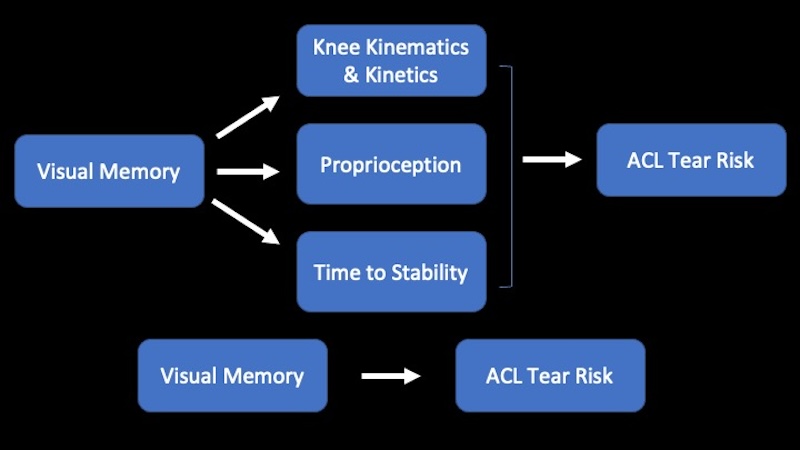
Speaking of Neurocognitive Testing: Head Trauma, The Neck and Performance
Heading frequency in soccer is related to cognitive performance. What’s more: heading is more related to cognitive performance than unintentional head impacts, like head-to-head or even head-to-goalpost collisions (Stewart et. al., 2018). The reasons for this relationship are most likely related to frequency—30 headers may add up to more trauma than the average head-to-head collision.
Heading frequency in soccer is related to cognitive performance. What’s more: heading is more related to cognitive performance than unintentional head impacts, says @KD_KyleDavey. Share on XNonetheless, the data definitely shows that headers decrease psychomotor speed and attention, and although it was not statistically significant, there are likely on-the-field and in-real-life implications for working memory (p = 0.06 in the Stewart paper cited above).
Moreover, 30.6% and 25.3% of soccer-related concussions are caused by headers in boys’ and girls’ U.S. high schools, respectively (Comstock et al., 2015).
So, we know heading decreases cognitive function and causes concussions. What does this have to do with the neck? Waring et. al. (2022) performed a fascinating study and provided deeper insights into neck–brain–body interconnectedness.
The researchers had a team of soccer players perform 20 headers back-to-back and then complete a neurocognitive screening test. Recall from the previous section that neurocognitive function—like visual memory—is believed to be a contributing factor to ACL tears and perhaps other injuries.
Half the soccer team performed neck-training for the next six weeks, the other half did not. The training was simple and consisted of band resisted neck extensions, flexions, and lateral flexions. Nothing else was different between the players’ training.
Then they re-did the protocol: 20 headers followed by neurocognitive testing.
The researchers found that “the cervical neck strengthening protocol allowed maintenance of visual memory scores.”
In other words: the control group, who did not perform neck training, experienced decreased neurocognitive function as a result of repeated head trauma, whereas athletes who had stronger necks did not suffer from neurocognitive deficits following head trauma.
The neck is, physically, the bridge between brain and body. Naturally, we must ask: is it farfetched to conclude that neck training has an impact on ACL-tear risk? I don’t believe so. Surely, there are a myriad of factors that contribute to any injury. To be clear, I do not propose that neck training eliminates risk. Of course not.
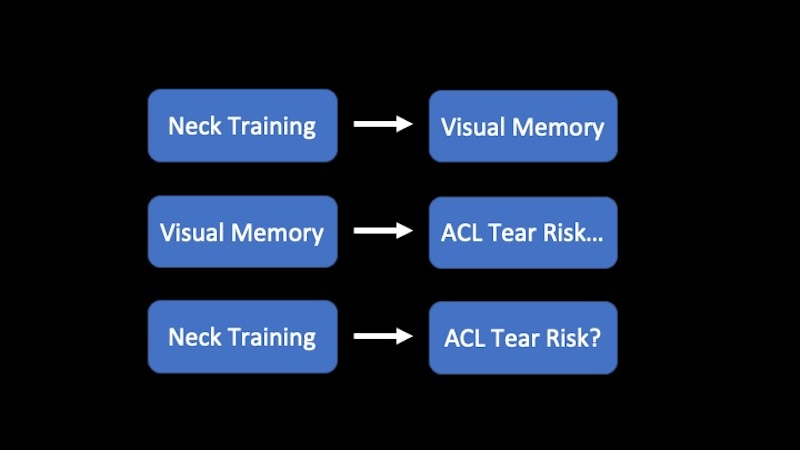
But is the neck a piece of the puzzle? I believe there is a neurological case to be made that, yes, neck health indeed does impact peripheral motor control, and thus, injury risk. So, I asked myself: is there research to show link between brain damage and ACL-tear risk?
And the Research Says…
…yes.
The research says there is a definitive link between concussion, brain health, and the risk of all kinds of injuries, not just ACL tears (Bertozzi et al., 2023; Gilbert et al., 2016; Hunzinger et al., 2021; Kakavas et al., 2021; Kakavas et al., 2023; McPherson et al., 2020; Phillips, 2022; Smulligan et al., 2022).
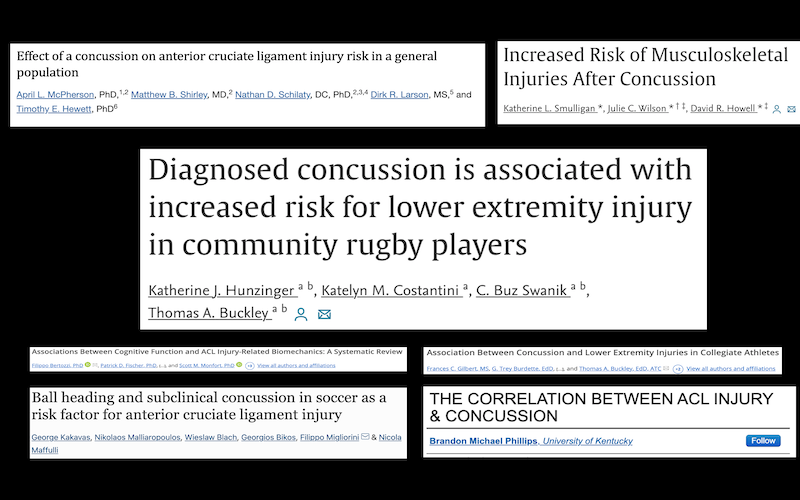
Neck Strength, Training, and Concussion Risk
There are a couple dozen papers I’m aware of that investigate or report on the relationship between neck strength, neck training, and concussion risk. Unfortunately, most of them are not of great quality.
For example, a couple of the papers I read do not specify the training protocol—they simply relay that athletes performed neck training for an amount of time. The exercises, volumes, and intensities are not reported. Another paper used bodyweight exercises that one of the authors presumably named after himself that were likely not exercises most strength coaches would implement. Thus, whether they report a protective effect against concussion or not, the results of these papers are relatively meaningless.
Perhaps the most commonly cited study in strength and conditioning circles is the 2014 Collins et al. paper. Undoubtedly, the most commonly quoted sentence from that paper is: “For every one-pound increase in neck strength, odds of concussion decreased by 5%.”
That is a head-turning sentence. One can deduce that adding 10 pounds of neck strength thus reduces concussion risk by 50%!
This led me to ask: how strong can a neck get? I’d never tested neck strength and was not familiar with such data. So, I looked and found an answer in a 2022 paper by Waring et al.
One can deduce that adding 10 pounds of neck strength thus reduces concussion risk by 50%! Says @KD_KyleDavey. Share on X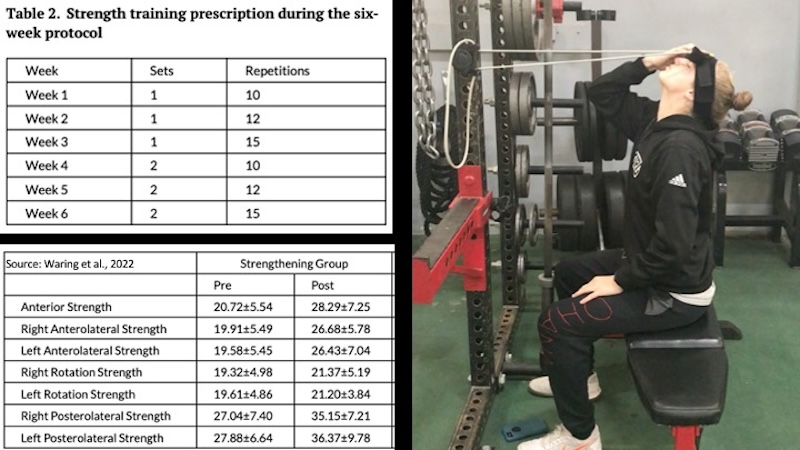
This was a fantastic project that clearly detailed the training protocol, as well as pre- and post-isometric strength measures. We see clear increases in neck strength after just six weeks of training with a simple, linearly progressed volume scheme.
We see clear increases in neck strength after just six weeks of training with a simple, linearly progressed volume scheme, says @KD_KyleDavey. Share on XThe athletes in this study increased anterior neck strength by about 7.5 pounds. Combining data from the Collins et al. study, one can conclude those athletes perhaps reduced concussion risk by 22.5%.
However, there are those who do not believe neck strength provides a protective benefit against concussion. In fairness, one can only conclude from the current state of the literature that the jury is still out. Literature reviews note inconclusive and mixed evidence. For instance, Cooney et al. (2022) states that “head-neck strength and size variables were at times associated with protection against mTBI incidence and reduced impact kinematics (14/22 studies found one or more head-neck variable to be associated with protection); however, some studies did not find these relationships (8/22 studies found no significant associations or relationships).”
A 2021 literature review (Daly et al.) concludes that “there is currently a lack of evidence to support the use of neck strengthening interventions in reducing impact injury risk in adult populations who participate in sport.”
As discussed previously in this article, many of the intervention-based research papers regarding neck strength and concussion risk are of dubious quality. It is my belief that those which were done well—like the 2022 Waring et al. project—do show a protective benefit.
For this reason, I’m a believer.
With that being said, it is worth noting that reducing risk cuts a fraction of a percentage. Different sports have differently reported risk values in terms of risk percentage. For argument’s sake, let’s say concussion risk is 3.5% for a sport you are interested in. A 50% reduction in risk would thus reduce overall risk of concussion to 1.75%. I believe it was Matt Tenan who I first saw propose this analysis.
Is the juice worth the squeeze to reduce absolute risk by 1.75%? Personally, I believe so—especially if we’re talking 10 to 15 minutes per week of training—but that is up to you as a coach to determine.
Neck Training: A Moral Obligation?
If you could reduce risk of an ACL tear with training, would you implement such methods?
Of course you would.
Without diminishing the effects of an ACL injury, I think we can agree the brain is much more important than the knee. Brain injuries can affect every aspect of one’s existence and experience of life. A 15-minute exercise done six times per week does the trick for strengthening the neck. With virtually no risk involved with the exercises (when properly performed), the risk/reward ratio is heavily in our favor.
If there’s even a chance that I can reduce the likelihood or severity of a brain injury in the athletes I work with, I’m going to do it.
Are you?
Since you’re here…
…we have a small favor to ask. More people are reading SimpliFaster than ever, and each week we bring you compelling content from coaches, sport scientists, and physiotherapists who are devoted to building better athletes. Please take a moment to share the articles on social media, engage the authors with questions and comments below, and link to articles when appropriate if you have a blog or participate on forums of related topics. — SF
References
Zabihhosseinian, M., Holmes, M. W., & Murphy, B. (2015). Neck muscle fatigue alters upper limb proprioception. Experimental brain research, 233, 1663-1675.
Majcen Rosker, Z., Vodicar, M., & Kristjansson, E. (2022). Is Altered Oculomotor Control during Smooth Pursuit Neck Torsion Test Related to Subjective Visual Complaints in Patients with Neck Pain Disorders?. International journal of environmental research and public health, 19(7), 3788.
Rosker, Z. M., Kristjansson, E., Vodicar, M., & Rosker, J. (2021). Postural balance and oculomotor control are influenced by neck kinaesthetic functions in elite ice hockey players. Gait & Posture, 85, 145-150.
Rosker, Z. M., Kristjansson, E., Vodicar, M., & Rosker, J. (2021). Postural balance and oculomotor control are influenced by neck kinaesthetic functions in elite ice hockey players. Gait & Posture, 85, 145-150.
Morrison, D.M. Russell, K. Kelleran, M.L. Walker, Bracing of the trunk and neck has a differential effect on head control during gait, J. Neurophysiol. 114 (2015) 1773–1783,
Noda, T., Nakajima, S., Sasano, T., & Shigeno, K. (1993). Importance of cervical muscles in galvanic body sway test. Acta Oto-Laryngologica, 113(sup503), 191-193.
Haavik, H., & Murphy, B. (2011). Subclinical neck pain and the effects of cervical manipulation on elbow joint position sense. Journal of manipulative and physiological therapeutics, 34(2), 88-97.
Zabihhosseinian, M., Holmes, M. W., & Murphy, B. (2015). Neck muscle fatigue alters upper limb proprioception. Experimental brain research, 233, 1663-1675.
Appelbaum, L. G., & Erickson, G. (2018). Sports vision training: A review of the state-of-the-art in digital training techniques. International Review of Sport and Exercise Psychology, 11(1), 160-189.
Lebeau, J. C., Liu, S., Sáenz-Moncaleano, C., Sanduvete-Ces, S., Chacón-Moscoso, S., Becker, B. J., & Tenenbaum, G. (2016). Quiet eye and performance in sport: A meta-analysis. Journal of Sport and Exercise Psychology, 38(5), 441-457.
Kung, S. M., Suksreephaisan, T. K., Perry, B. G., Palmer, B. R., & Page, R. A. (2020). The effects of anticipation and visual and sensory performance on concussion risk in sport: a review. Sports Medicine-Open, 6, 1-14.
Boynton, A. M., & Carrier, D. R. (2022). The human neck is part of the musculoskeletal core: cervical muscles help stabilize the pelvis during running and jumping. Integrative Organismal Biology, 4(1), obac021.
Chaput, M., Onate, J. A., Simon, J. E., Criss, C. R., Jamison, S., McNally, M., & Grooms, D. R. (2022). Visual cognition associated with knee proprioception, time to stability, and sensory integration neural activity after ACL reconstruction. Journal of Orthopaedic Research®, 40(1), 95-104.
Grooms, D. R., Chaput, M., Simon, J. E., Criss, C. R., Myer, G. D., & Diekfuss, J. A. (2023). Combining Neurocognitive and Functional Tests to Improve Return to Sport Decisions Following ACL Reconstruction. Journal of Orthopaedic & Sports Physical Therapy, (0), 1-14.
Waring, K. M., Smith, E. R., Austin, G. P., & Bowman, T. G. (2022). Exploring the Effects of a Neck Strengthening Program on Purposeful Soccer Heading Biomechanics and Neurocognition. International Journal of Sports Physical Therapy, 17(6), 1043.
Stewart, W. F., Kim, N., Ifrah, C., Sliwinski, M., Zimmerman, M. E., Kim, M., … & Lipton, M. L. (2018). Heading frequency is more strongly related to cognitive performance than unintentional head impacts in amateur soccer players. Frontiers in neurology, 9, 240.
Comstock, R. D., Currie, D. W., Pierpoint, L. A., Grubenhoff, J. A., & Fields, S. K. (2015). An evidence-based discussion of heading the ball and concussions in high school soccer. JAMA pediatrics, 169(9), 830-837.
McPherson, A. L., Shirley, M. B., Schilaty, N. D., Larson, D. R., & Hewett, T. E. (2020). Effect of a concussion on anterior cruciate ligament injury risk in a general population. Sports medicine, 50(6), 1203-1210.
Smulligan, K. L., Wilson, J. C., & Howell, D. R. (2022). Increased risk of musculoskeletal injuries after concussion. Operative Techniques in Sports Medicine, 30(1), 150896.
Hunzinger, K. J., Costantini, K. M., Swanik, C. B., & Buckley, T. A. (2021). Diagnosed concussion is associated with increased risk for lower extremity injury in community rugby players. Journal of science and medicine in sport, 24(4), 368-372.
Bertozzi, F., Fischer, P. D., Hutchison, K. A., Zago, M., Sforza, C., & Monfort, S. M. (2023). Associations between cognitive function and ACL injury-related biomechanics: a systematic review. Sports health, 19417381221146557.
Gilbert, F. C., Burdette, G. T., Joyner, A. B., Llewellyn, T. A., & Buckley, T. A. (2016). Association between concussion and lower extremity injuries in collegiate athletes. Sports health, 8(6), 561-567.
Phillips, B. M. (2022), The correlation between ACL injury and concussion.
Kakavas, G., Giannakopoulos Sr, I., Tsiokanos, A., Potoupnis, M., & Tsaklis, P. V. (2023). The effect of ball heading and subclinical concussion on the neuromuscular control of the lower limb: a systematic review. International journal of sports physical therapy, 18(5), 1054.
Kakavas, G., Malliaropoulos, N., Blach, W., Bikos, G., Migliorini, F., & Maffulli, N. (2021). Ball heading and subclinical concussion in soccer as a risk factor for anterior cruciate ligament injury. Journal of orthopaedic surgery and research, 16, 1-4.
Tabbert H, Ambalavanar U, Murphy B. Neck Muscle Vibration Alters Upper Limb Proprioception as Demonstrated by Changes in Accuracy and Precision during an Elbow Repositioning Task. Brain Sci. 2022 Nov 12;12(11):1532. doi: 10.3390/brainsci12111532. PMID: 36421856; PMCID: PMC9688255.

